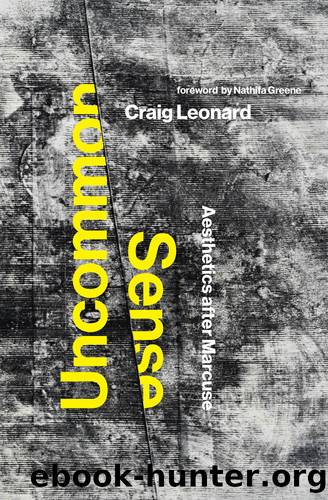Uncommon Sense by Craig Leonard

Author:Craig Leonard [Leonard, Craig]
Language: eng
Format: epub
Publisher: MIT Press
Coda: Misreading Marcuseâs Aesthetics
Some of the main commentators in the 1960s and 1970s on Herbert Marcuseâs aestheticsâincluding the art critics Ursula Meyer, Jack Burnham, Harold Rosenberg, and Gregory Battcockâoften raised questions about the connection he makes between art and politics. What exactly is it about artâs âinternal exigencyâ1 that links it with political practice? How can artâs indirect political character have actual political effects? Can these political effects be measured, identified, or nurtured? Ultimately, must the artist step outside of art (that is, become a non-artist or harmonic anti-artist) to engage in direct political activity? A main purpose of this book has been to address such questions by closely analyzing Marcuseâs aesthetic theory to show his overlooked relevance to the discourse on contemporary art and politics. This coda looks at some of the main criticisms and misreadings of Marcuseâs aesthetics specifically by Meyer, Burnham, Rosenberg, and Battcock and, in the process, applies some of the terminology and issues that were addressed in depth in the preceding chapters.
Marcuseâs essay âArt in the One-Dimensional Societyâ was published in the periodical Arts Magazine in May 1967. In the same year, art historian George Kubler published âStyle and the Representation of Historical Timeâ in the multimedia magazine Aspen (no. 5+6, âThe Minimalism Issueâ), which was a synopsis of his admired, but now mostly forgotten, book titled The Shape of Time: Remarks on the History of Things (1962). There are strong affinities between Marcuse and Kubler in the formerâs notion of âradical sensibilityâ and latterâs category of âradical human invention.â Curiously, however, Marcuseâs aesthetic theory has mainly been viewed as anachronistic and conservative while, at the time, Kublerâs was seen as innovative and progressive. It is known, for instance, that Kubler influenced artists such as Robert Smithson, Robert Morris, Asger Jorn, Brian OâDoherty, and Ad Reinhardt (who even wrote a review of Kublerâs book for Art News).2
At the core of The Shape of Time he presents two models of human invention: the production of tools based on changing needs and the production of artworks beyond immediate needs. Where the first signifies inventions to serve some utility, the second refers to inventions of ânon-instrumental use.â3 Artâs non-instrumentality, however, does not mean it is of lesser value than useful invention. On the contrary, aesthetic invention is the âchannel to the universe,â since it âalters the sensibility of mankind [and when] the capacity of that channel can be increased, knowledge of the universe will expand accordingly.â4 Where human inventions take on varying degrees of expansion, the most transformative is non-instrumental âradical invention,â5 which âdiscards ready-made positions, [such that] the investigator constructs his own system of postulates and sets forth to discover the universe they alone can disclose.â6 While the invention of artworks and tools are âamong ways of altering the set of the mind,â it is exclusively radical artistic invention that alters the governing âsystem of postulatesâ that construct common sense. While tools are limited to solving matters at hand, radical artistic inventions, in their non-instrumentality, confront âelements already given to the observer.
Download
This site does not store any files on its server. We only index and link to content provided by other sites. Please contact the content providers to delete copyright contents if any and email us, we'll remove relevant links or contents immediately.
The remains of the day by Kazuo Ishiguro(8828)
Tools of Titans by Timothy Ferriss(8225)
Giovanni's Room by James Baldwin(7199)
The Black Swan by Nassim Nicholas Taleb(7016)
Inner Engineering: A Yogi's Guide to Joy by Sadhguru(6728)
The Way of Zen by Alan W. Watts(6511)
Asking the Right Questions: A Guide to Critical Thinking by M. Neil Browne & Stuart M. Keeley(5651)
The Power of Now: A Guide to Spiritual Enlightenment by Eckhart Tolle(5610)
The Six Wives Of Henry VIII (WOMEN IN HISTORY) by Fraser Antonia(5398)
Astrophysics for People in a Hurry by Neil DeGrasse Tyson(5134)
Housekeeping by Marilynne Robinson(4349)
12 Rules for Life by Jordan B. Peterson(4250)
Double Down (Diary of a Wimpy Kid Book 11) by Jeff Kinney(4208)
The Ethical Slut by Janet W. Hardy(4178)
Skin in the Game by Nassim Nicholas Taleb(4165)
Ikigai by Héctor García & Francesc Miralles(4125)
The Art of Happiness by The Dalai Lama(4063)
Skin in the Game: Hidden Asymmetries in Daily Life by Nassim Nicholas Taleb(3935)
Walking by Henry David Thoreau(3897)
